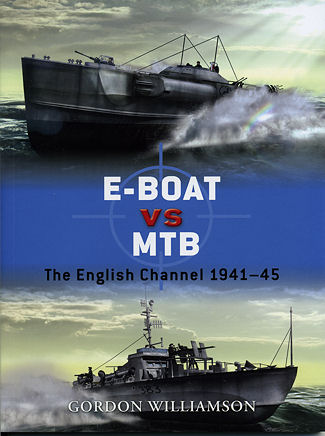 This is
#34 in Osprey's very popular Duel series and covers the German E-Boat and the
British MTB as they operated in the English Channel area during WWII.
This is
#34 in Osprey's very popular Duel series and covers the German E-Boat and the
British MTB as they operated in the English Channel area during WWII.| Author | Peter Davies |
|
Publisher/Distributor |
Osprey Publishing |
|
Price |
$17.95 MSRP |
|
Reviewer: |
|
| Notes: |
80 pages, 7¼ x 9¼ inches, softcover ISBN: 978-1-84908-471-0 |
 This is
#34 in Osprey's very popular Duel series and covers the German E-Boat and the
British MTB as they operated in the English Channel area during WWII.
This is
#34 in Osprey's very popular Duel series and covers the German E-Boat and the
British MTB as they operated in the English Channel area during WWII.
At the start of the war, the Germans were way ahead of the British in the operation of this type of vessel. The British had apparently not considered coastal defense and offensive operations and had but three MTB type vessels available. Needless the say, the Germans really began operations against shipping once it had Channel ports from which to operate after the fall of France.
There was a difference in how these particular boats were built. The British MTB was pretty much the same as US PT boats. Not surprising as it was from the British that the US design was developed. These were lightweight, rather lightly armed and armored, and quite quick. The German E-boats (actually E-boat is a British name from 'Enemy Boat'. The Germans called them S-boats for Schnell Boats), were much larger, more heavily armed and armored and while not quite as nimble, were quite quick. I also believe the E-boats were steel whereas the MTB was wood.
As with tanks, there were very few boat vs boat battles. Most of the time, these boats were attacking enemy shipping or, in the case of the Germans, laying mines. Much of the tonnage sunk by E-boats was not from direct combat, but from mines. Second only to the U-boat in terms of tonnage sunk during the war, the E-boat was actually quite successful. Not only that, but they also had a rather high survival rate with only about 15% of E-boat crews not surviving the war compared to 80% of U-boat crews.
In line with other books in this series, the author takes a look at the design and development of both of the weapons systems, then looks at the strategic situation in which these fast boats found themselves during the war. There is a section on the technical specifications of the boats, followed by a piece on the training of the combatants. Much of the book then goes on to detail the combat action between the two forces, following up with an analysis of the event and what came afterwards.
All of this is superbly illustrated with maps, cutaways, and period photographs, making this edition a must-have for those interested in these two interesting light combat boats.
July 2011
For more on the complete line of Osprey books, visit www.ospreypublishing.com. In the US, it is Osprey Direct at 44-02 23rd St, Suite 219, Long Island City, NY 11101., where you can get a catalogue of available books.
If you would like your product reviewed fairly and fairly quickly, please contact the editor or see other details in the Note to Contributors.